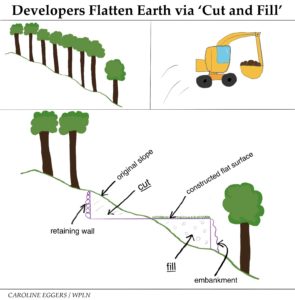
Dirt sets Earth apart from other rocky, lifeless planets in the universe.
The stuff beneath our feet regulates the climate, provides food and purifies water, sustaining life. In Earth’s 4.5 billion year history, soil is thought to have formed about 500 million years ago, around the time of the first land plants and animals.
Soil can reverse global heating by sucking up carbon dioxide from the atmosphere, and it is also the foundation for human infrastructure.
In 2022, soil was a key factor in all of Tennessee’s major environmental disasters.
- Heat
In cities, concrete and asphalt create “urban heat islands” partially because they block soil. Soil houses the shade-giving trees and vegetation, and it evaporates heat-absorbing water.
Nashville has been getting hotter, on average, every month of the year. This past summer was the sixth hottest on record – July was the second hottest, with only four days that did not reach 90 degrees or more. Nashville also had its fifth-longest streak of 90-plus-degree days.
This heat is felt unevenly across town. In August, National Oceanic and Atmospheric Administration organized a heat data collection effort, which will be translated into a public map.
With fewer trees and more concrete, Nashville is heating up. What’s the plan?
- Drought
The same processes in soil that help regulate temperature are also involved in the hydrologic cycle. That was evident during Tennessee’s first drought this summer.
Heat and drought are part of a feedback loop. When water is scarce, trees and plants drink up moisture from the soil, and that moisture usually helps soak up surface heat.
“If we think about all of the energy coming from the sun that gets turned into what we feel as the temperature of the air, if we’ve got a drought going on, all of the energy that would normally go into evaporating water or transpiring water gets just turned into heat energy,” William Tollefson, Tennessee’s assistant state climatologist, said in July.
In the past two months, Tennessee has been experiencing a second drought, which recent rains mitigated in most of Nashville and eastern Tennessee. Unlike a quick summer drought, this drought shrunk soils enough to break water pipes in Nashville.
One consequence of the drought you might not have guessed — more broken water pipes
- Heavy rains and landslides
Last year was the year of extreme rain in Tennessee, and it highlighted serious risks, ranging from hazardous chemical facilities to ground movement. The aftermath stuck around this year.
In March 2021, an eight-inch rainfall triggered a 300-foot-wide landslide in South Nashville.
Basically, the soil-plant process of evapotranspiration shuts down in the colder months, allowing hillsides to saturate while groundwater levels climb. This makes soils unstable in the springtime. If you add a massive rain on top, these soils can slide.
While rain-driven landslides are prominent across the globe, this is a new climate phenomenon for highly developed cities like Nashville – and the way we cut and move soils to build on hills is another major factor in landslides.
Landslides are a growing threat in Nashville. Blame climate change and developers.
- Pipelines
Water pipes are not the only pipelines at risk from changing soil. In June, a 1,000-mile pipeline leaked at least 180,000 gallons of crude oil from a 7-inch crack into Chester County during Tennessee’s second-largest oil spill to date. It barely missed the state’s largest aquifer, partially because the creek it flowed into was low and stagnant thanks to the summer drought.
A worker clearing vegetation in the transmission right-of-way struck the pipeline with an industrial-strength lawn mower. The steel pipeline was exposed “due to loss of cover,” according to a federal report.
In other words, the soil had weathered away. The federal report on the spill indicates that the pipeline was buried under four feet of soil about 70 years ago.
This is one of the main issues that the Pipeline and Hazardous Materials Safety Administration warned pipeline owners and operators to monitor in a notice this summer.
“Changing weather patterns due to climate change, including increased rainfall and higher temperatures, may impact soil stability in areas that have historically been stable,” PHMSA wrote, citing more than a dozen cases in recent years. “Slope instability, subsidence, frost heave, soil settlement, erosion, earthquakes, and other dynamic geologic conditions…may pose a safety risk.”
Tennessee’s massive oil spill cost $4.7 million. A federal investigation says it poured from a 7-inch crack.
- Future disasters
Soil is constantly changing, but humans are disrupting the soil ecosystem. We are weathering it away, or just smothering it, faster than it is replenishing.
A hotter planet – and more intense storms – will further unearth new disasters. Soil will be part of the story.
One way for Tennessee to adapt is to build a mesonet, which is a network of weather stations that monitor various ground-level conditions, including soil moisture. These stations can help forecasters make precise calls and issue earlier warnings across the entire state, if placed in every county.
When dangerous weather strikes, most states rely on ‘mesonet’ infrastructure for better forecasts and earlier warnings. But Tennessee doesn’t have one.



